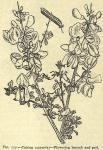 The dried tops of Cyti'sus scopa'rius (Linné) Link. Habitat: Europe and Asia.
The dried tops of Cyti'sus scopa'rius (Linné) Link. Habitat: Europe and Asia.
DESCRIPTION OF DRUG.—Thin, flexible, branched twigs, pentangular and winged, nearly smooth, and of a dark greenish-brown color; as found in the market they are usually free- from the small trifoliate leaves. Odor slight, stronger when bruised; taste very bitter.
Powder.—Greenish-brown. Characteristic elements: Sclerenchyma with bast fibers, long, thick-walled, associated with crystal fibers containing calcium oxalate prisms; ducts, spiral, annular, and reticulate; trichomes, non-glandular (0.5 to 0.7 µ in diam.), thick-walled, yellowish, one-celled; pollen, brownish; grains, oval.
CONSTITUENTS.—A neutral crystalline principle, scoparin, C20H20O10 + 5H2O, to which the diuretic action is due, and the colorless, volatile, liquid alkaloid, sparteine, C15H26N2, acting as a powerful cardiac tonic; this is oily, very bitter, soluble in alcohol, chloroform, and ether; it has been made official as the salt, sparteinae sulphas. Prisms freely soluble in, water. Oxidation products, such as oxysparteine, C15H24N2O, produce an increase of heart activity, while dioxysparteine, C15H26N2O, produces an inverse effect upon the heart. Sparteine has an anilinelike odor.
Preparation of Scoparin.—Allow a concentrated decoction of broom-tops to gelatinize; express and purify the jelly-like mass by repeated solution in hot water, and finally in hot alcohol.
Preparation of Sparteine.—Extract plant with acidulated water and distil concentrated liquid with NaOH. A colorless oily liquid, forming crystalline salts. Sulphate official.
ACTION AND USES.—Scoparius is a reliable diuretic and laxative in small doses of 10 to 30 gr. (0.6 to 2 Gm.), and is an efficient remedy in dropsy. Dose of sparteinae sulphas: 1/8 to 1 gr. (0.0081 to 0.065 Gm.). Used to regulate heart action.

